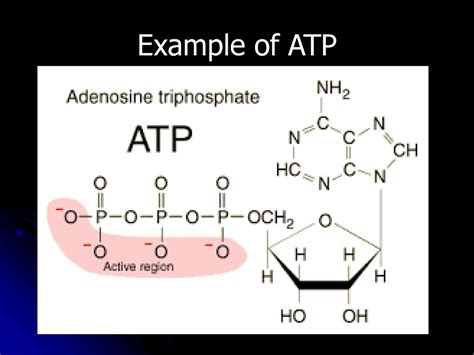ATP, or adenosine triphosphate, is a nucleotide that serves as the main energy currency of cells. It is a small molecule that consists of an adenine molecule attached to a ribose sugar molecule, which in turn is attached to three phosphate groups.

ATP is a high-energy molecule because it has a high potential for hydrolysis, which is the breakdown of a molecule by the addition of water. When ATP is hydrolyzed, it releases energy that can be used to power cellular processes.
ATP is involved in a wide variety of cellular processes, including:
- Muscle contraction
- Nerve impulse transmission
- Cell division
- Protein synthesis
- DNA replication
Structure of ATP
ATP is a relatively small molecule, with a molecular weight of 507.18 g/mol. It consists of three components:
- Adenine is a nitrogenous base.
- Ribose is a five-carbon sugar.
- Three phosphate groups are attached to the ribose molecule.
The three phosphate groups are arranged in a linear fashion, with the first phosphate group being attached to the 5′ carbon of the ribose molecule, and the second and third phosphate groups being attached to the 4′ and 3′ carbons, respectively.
Function of ATP
ATP is the main energy currency of cells. It is used to power a wide variety of cellular processes, including:
- Muscle contraction
- Nerve impulse transmission
- Cell division
- Protein synthesis
- DNA replication
ATP is hydrolyzed to ADP (adenosine diphosphate) and inorganic phosphate (Pi) when it releases energy. The energy released by ATP hydrolysis is used to drive cellular processes.
Regulation of ATP Levels
The levels of ATP in cells are tightly regulated. This is important because ATP is essential for cell survival. If ATP levels drop too low, cells will die.
There are a number of mechanisms that regulate ATP levels in cells, including:
- ATP synthesis is the process of producing ATP. ATP synthesis occurs in the mitochondria of cells.
- ATP hydrolysis is the process of breaking down ATP to release energy. ATP hydrolysis occurs in the cytoplasm of cells.
- ATP salvage pathways are processes that recycle ATP from ADP and AMP (adenosine monophosphate). ATP salvage pathways occur in the cytoplasm of cells.
Clinical Significance of ATP
ATP is a key molecule in a number of diseases. For example, ATP levels are decreased in patients with mitochondrial diseases. Mitochondrial diseases are a group of disorders that affect the mitochondria of cells. Mitochondria are responsible for producing ATP, so when they are damaged, ATP levels drop. This can lead to a number of symptoms, including fatigue, muscle weakness, and organ failure.
ATP is also a key molecule in cancer. Cancer cells have a high demand for energy, so they produce more ATP than normal cells. This increased ATP production helps to fuel the growth and spread of cancer cells.
Conclusion
ATP is a small but essential molecule that plays a key role in a variety of cellular processes. It is the main energy currency of cells and is involved in a wide range of activities, including muscle contraction, nerve impulse transmission, cell division, protein synthesis, and DNA replication. The levels of ATP in cells are tightly regulated to ensure that cells have the energy they need to survive and function properly.
Tables
| Table 1. ATP levels in different cell types |
|—|—|
| Cell type | ATP concentration (mM) |
|—|—|
| Muscle cells | 5-10 |
| Nerve cells | 2-5 |
| Liver cells | 1-2 |
| Table 2. Rate of ATP hydrolysis in different cell types |
|—|—|
| Cell type | Rate of ATP hydrolysis (nmol/min/mg protein) |
|—|—|
| Muscle cells | 100-200 |
| Nerve cells | 50-100 |
| Liver cells | 25-50 |
| Table 3. ATP turnover rate in different cell types |
|—|—|
| Cell type | ATP turnover rate (times/min) |
|—|—|
| Muscle cells | 10-20 |
| Nerve cells | 5-10 |
| Liver cells | 2-5 |
| Table 4. ATP regeneration pathways |
|—|—|
| Pathway | Reaction |
|—|—|
| Substrate-level phosphorylation | ADP + Pi + Substrate → ATP + Product |
| Oxidative phosphorylation | NADH + H+ + O2 + ADP + Pi → ATP + H2O |
| ATP salvage pathways | ADP + AMP → ATP |
